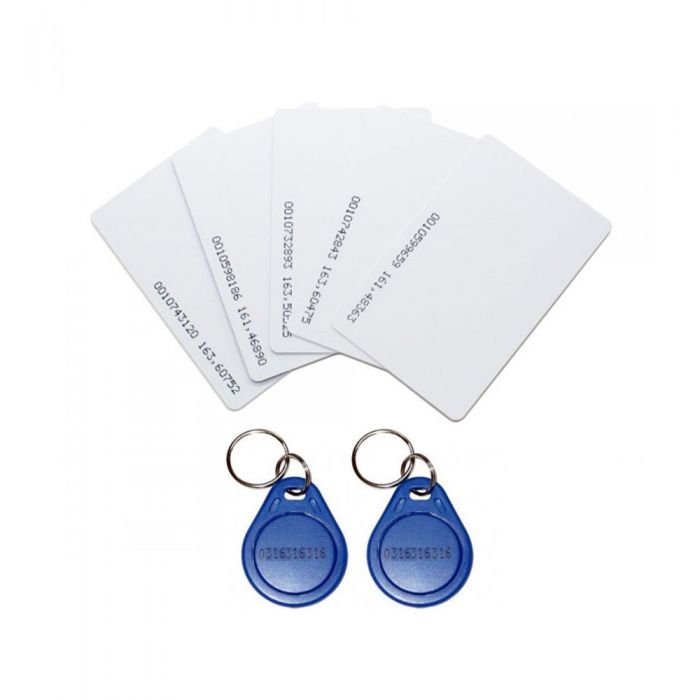Description
Barcode & QR Code Cards
Barcodes and QR code cards are very similar. Both types of cards are scanned by access control points with an infrared beam of light. The attached computer system translates the code into user access credentials and authenticates the user.
These two types of cards differ primarily in how much information each can store. Barcodes can store about one hundred characters of data. QR codes can store several thousand.
Code cards are inexpensive, but also low security. The codes can easily be copied with a smartphone camera or photocopier. If an access reader is unattended, a criminal could simply wave a copied barcode at it to gain access. Therefore, these types of cards are only useful for low-risk access control needs.
Magstripe Cards
These are also called swipe cards. They use the same technology as traditional credit cards, where credentials are encoded on a magnetic strip embedded in a plastic card.
Magstripe cards are more secure than barcodes, but only by a small degree. Magstripe duplicators and writers are readily available online. They allow anyone, including criminals, to copy or overwrite any card they get a hold of.
Magstripe cards are appropriate for low-risk access control where card loss or theft will not present an urgent liability to the resource you’re protecting. Real Time Networks’ technology partner Lenel sells magstripe systems as part of its OnGuard platform.
Wiegand Cards
A unique credential number is encoded as a magnetic pattern onto a metal wire embedded within a card. Wiegand cards first became popular in the 1980s as a more secure alternative to the barcode and magstripe cards available at the time. The unique credential codes are encoded at the time of manufacture, which means cards can’t be reprogrammed or easily erased.
Wiegand cards are still commonly used today in medium-security settings. But their security advantage has recently been made obsolete by newer wireless technology, like RFID.
Radio Frequency Identification (RFID) Cards
RFID computer chips may be small enough to fit onto an access card, but they can store up to 32 kilobytes of data, or roughly the same amount as 32 QR codes.
More importantly, RFID chips can be encrypted, which makes them incredibly hard to duplicate or forge. Data can be modified or overwritten by authorized security personnel, so RFID cards are also more customizable than older alternatives.
RFID access cards transmit their credentials via a short-range wireless signal. Because they are non-contact, these cards are more sanitary than their alternatives, and they are less prone to wear.
Two different kinds of RFID cards currently dominate the market, each with their own advantages:
RFID Prox Cards
Prox cards perform a simple, one-way transmission of credentials from a card to a reader. Because they send information wirelessly, they only need to be in close proximity to a reader, hence the nickname prox card.
Both AMAG and Lenel offer low-cost prox card access control systems. Real Time Networks solutions easily integrate with the prox cards offered by both vendors.
RFID Smart Cards
Smart cards are designed to provide both secure and fast access control. They have built-in processors, meaning cards are essentially miniature single-purpose computers.
Unlike prox cards, smart cards are able to communicate back and forth with card readers, which allows for much more advanced encryption. Each time an RFID smart card is read at an access control point, it authenticates the user with a single-use encrypted code. Attackers can’t simply copy the same encrypted signal and resend it, because that code will no longer work.
Smart cards are incredibly hard to duplicate, which makes them suitable for high-security environments.
Alternate Solutions
These systems don’t use cards but are often considered as alternative options for access control.
- Biometrics: Biometric access control readers scan and compare a unique, physical characteristic of a user and authenticate it against a stored record. Fingerprints and eye irises are common features used for biometric authentication. Biometric readers are reliable and highly secure, but come at a higher price point.
- PIN codes: PIN code keypads can be the right level of access control in low-security settings. Access is restricted to anyone who knows a code, but there is no way to verify an individual’s identity.
- Smartphones: Now that they’re ubiquitous, smartphones with a secure authentication app are increasingly used for access control. This turns a smartphone into a kind of digital key ring.
With so many different accesses control options on the market, how do businesses choose the one right for their needs?
Call us we guide you.







Reviews
There are no reviews yet.